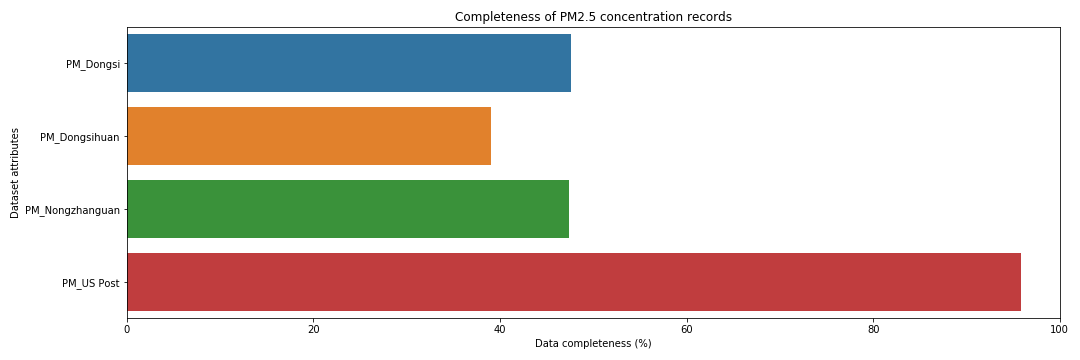This repo is created for storing relevant programs used in my air quality prediction project.
Found in UCI Machine Learning Repository, the dataset is a collection of
PM2.5 concentration statistics in five Chinese cities between the beginning of
2010 and the end of 2015, and we only use the dataset of Beijing
(BeijingPM20100101_20151231.csv).
After some data preprocessing, we classify the dataset attributes (columns) into two types:
- Label columns: All these columns combined denote the time when the values are recorded.
- year: Year of the record
- season: 1=Spring, 2=Summer, 3=Fall, 4=Winter
- month: Month of the record
- day: Day of the record
- hour: Hour at which the row is recorded
- Value columns: PM2.5 concentration and other meteorological parameters
- PM_Dongsi,PM_Dongsihuan,PM_Nongzhanguan,PM_US Post: PM2.5 Concentration measured in different stations (ug/m3)
- DEWP: Celsius Dew Point
- TEMP: Celsius temperature
- HUMI: Humidity (%)
- PRES: Air Pressure (hPa, i.e. 1 hPa=100 Pa)
- precipitation: Precipitation (millimeters)
- Iprec: Cumulated precipation (millimeters)
- cbwd: Combined wind direction (
cvrefers to still wind,NEand others refer to geographic direction) - Iws: Cumulated wind speed (m/s)
Dataset's Digital Object Identifier (DOI): doi:10.1002/2016JD024877
Citation:
Liang, X., S. Li, S. Zhang, H. Huang, and S. X. Chen (2016), PM2.5 data reliability, consistency, and air quality assessment in five Chinese cities, J. Geophys. Res. Atmos., 121, 10220-10236.
Technical details about this section can be found in
pm25_preprocessing.ipynb
We discovered that this dataset contains both outliers and missing values, so we follow certain schemes to remove anomalous values and refill them with missing value imputation techniques. First, we identify any values that do not fall within a specific normal range as outliers. Then, we set these values to NAN and handle them with imputation techniques.
The original dataset contains many missing values, and more of them emerge after removing anomalies. As a result, we adopt a variety of methods to impute them: we use Next Observation Carried Backward (NOCB) to impute missing values appearing at the beginning of the records; we use Last Observation Carried Forward (LOCF) to handle missing values at the end of the records; and at last, we use linear interpolation to handle missing values that emerge in rest of the places.
Since the dataset contains PM2.5 measured by multiple stations, we decide to impute and use the PM2.5 data measured in the U.S. Diplomatic Post because it contains the most complete PM2.5 data in compared to those in other stations.
In our dataset, not every attribute can be expressed in terms of real numbers.
For instance, cbwd (Combined wind direction) is a categorical attribute and
cannot be imputed using numerical methods. Hence, we only use NOCB and LOCF
methods to handle missing values of these non-numerical attributes.
Following the imputation, we assign different numbers to different values of
categorical features. In particular, we use the following instruction to handle
cbwd attributes (in which data refers to the dataframe object of the
dataset).
data["cbwd"]=data["cbwd"].map({"cv":0,"NW":1,"NE":2,"SE":3})After data preprocessing, we begin analyzing the dataset itself.
Technical details about this section can be found in
pm25_features.ipynb
This section will be available in my report that will be published.
